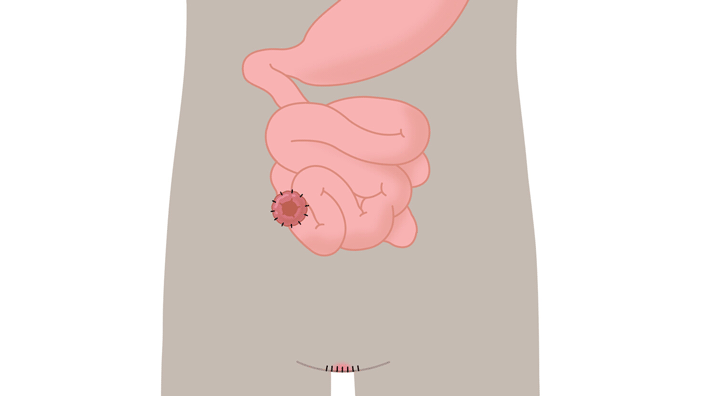
What is an ileostomy?
In an ileostomy operation, a part of your small bowel called the ileum is brought to the surface of your abdomen to form the stoma.
After surgery, your stoma may be quite swollen to begin with, but will reduce in size over time – usually after six to eight weeks.
No sensation, no pain
A stoma is red in colour. This is because it is a mucous membrane, just like the mucous membrane inside your mouth. There is no sensation in the stoma, so it is not at all painful to touch. The stoma can bleed a little when being cleaned, especially in the beginning, but this is quite normal, and should stop shortly afterwards.
Stomas come in all different shapes and sizes - some are quite short and sit flat against the belly, while some protrude a little. Some people will have more than one stoma, depending on their condition.

In an ileostomy operation, a part of your small bowel called the ileum is brought to the surface of your abdomen to form the stoma.
In an ileostomy operation, a part of your small bowel called the ileum is brought to the surface of your abdomen to form the stoma. An ileostomy is typically made in cases where the end part of the small bowel is diseased, and is usually made on the right-hand side of your abdomen.
Stools in this part of the intestine are generally fluid and, because a stoma has no muscle to control defecation, will need to be collected in a pouch.
There are two different types of ileostomy surgery: End Ileostomy and loop ileostomy.
End ileostomy
An end ileostomy is made when part of your large bowel (colon) is removed (or simply needs to rest) and the end of your small bowel is brought to the surface of the abdomen to form a stoma. An end ileostomy can be temporary or permanent.
The temporary solution is relevant in situations where the diseased part of the bowel has been removed and the remaining part needs to rest before the ends are joined together. The permanent solution is chosen in situations where it is too risky or not possible to re-join the two parts of the intestine.
Loop ileostomy
In a loop ileostomy, a loop of the small bowel is lifted above skin level and held in place with a stoma rod. A cut is made on the exposed bowel loop, and the ends are then rolled down and sewn onto the skin. In this way, a loop ileostomy actually consists of two stomas that are joined together.
The loop ileostomy is typically temporary and performed to protect a surgical join in the bowel. If temporary, it will be closed or reversed in a later operation.
Generally, with an ileostomy you will need to use a drainable bag.
Generally, with an ileostomy you will need to use a drainable bag. You may want to move away from the clear bag fitted immediately after your operation to an opaque version that could also be smaller.
There are two main types of systems:
- One-piece system
This consists of a collection bag with an integrated adhesive baseplate, which fits firmly around your stoma.
- Two-piece system
In the two-piece system, the collection bag is separate from the adhesive baseplate, and the two halves are securely clipped or sealed together. This means that you don’t have to remove the adhesive plate from around the stoma every time you change the bag.

What to expect after stoma surgery
Read more about what to expect after ostomy surgery and adjusting to life with your new stoma.

How can Coloplast Care make a difference for you?
- Reliable advice, whenever you need it
- Supplement the education and advice you get from your stoma care nurse
- Guidance on selecting the right products
- Easy access to samples of relevant products
- Free home visits by Coloplast Stoma Care nurses
Life with an ostomy isn't always straightforward. So why go it alone?
